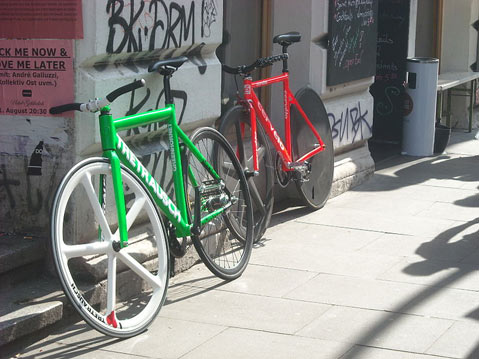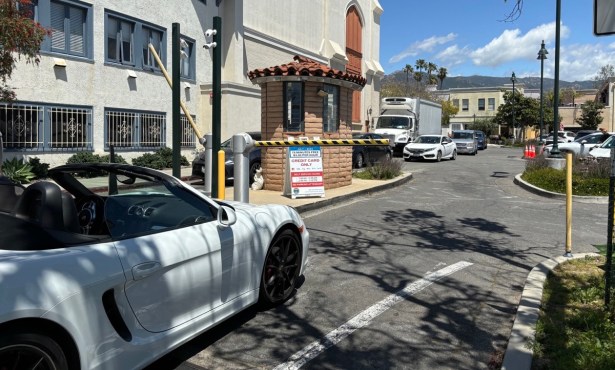The Fixie Phenomenon
Fixed-Gear Bikes Take Some Getting Used to, but Many Love Them

Fixed-gear bicycles were once reserved for velodrome racers and bicycle messengers. However, recent years have seen gains in fixie use among recreational riders, leading to increased interest in cycling, a unique cultural scene, and controversy regarding the bike’s use.

Fixed-gear bikes operate much like a child’s tricycle; if the wheels are moving, the pedals are moving. There is no freewheel to allow for coasting, and riders must keep their legs in motion at all times. Changing pace, maneuvering, and especially turning can be quite challenging on a fixed-gear bike, spurring heated debate among cyclists about their efficacy, safety and practicality.
The Other Woman
Jim Cadenhead, owner of Cranky’s Bikes in Santa Barbara, says the allure of a fixie is in the unique riding experience it offers. “I tell people it’s like a mistress bike. You know what your regular bike feels like, and this one just feels different.”
Cadenhead was introduced to this type of bicycle during his decade-long stint as a bike messenger on the East Coast. Aside from their mysterious intrigue, he says the low-tech bicycles offer some distinct advantages, particularly for messengers required to work during poor weather conditions. “During deliveries in snow and ice, it’s going to freeze your brake cables and pack in between your gears,” explains Cadenhead. A fixie can help cyclists avoid these problems. “Because you’re directly linked to the rear wheel, you can tell when you’re getting traction,” Cadenhead says. “It’s easier to control what the rear wheel is doing. For those reasons, they were instantly popular with messengers.”
Reliable and Ready-to-Ride
Fixies are often less expensive to buy and to maintain than geared bikes. The simple design requires little upkeep, and the lack of components makes them lightweight. These features appeal to college students lacking time and money to invest in cycling but needing quick, easy transportation to classes.
Mike Rogers, UCSB’s AS Bike Shop Coordinator, has noticed the rising popularity of fixed-gear bikes among the students on campus. “I have seen a marked increase,” says Rogers, who notes that the bike’s simplicity is highly appealing to students because mechanically there are “less things to go wrong.”
Cadenhead thinks the low upkeep makes the bike a good option for campus. “They are great bikes, especially for students because there is no maintenance, you can get one and beat it up for four years, and it’ll still keep going.”
Skidding to a Stop
Perhaps the most controversial topic surrounding fixed-gear bikes is brake use, or lack thereof. Many fixie bikes have no hand brakes. UCSB junior Kevin Ray Li believes eschewing brakes is essential to fixed-gear cycling, “I don’t have brakes on my bike. You aren’t truly riding fixed unless you’re riding brakeless.” Li sees riding without brakes as enhancing his awareness and handling skills. “It forces you to learn how to predict what riders around you are going to do. This is a skill that you should know even if you are riding with brakes.”
On a brakeless fixie, the only means of stopping the bike is stopping the pedals, which may be circling at a very high rpm. A gradual stop can be achieved by slowing the rate of pedaling; however, riders must master special techniques necessary for immediate stops.
Locking up the back wheel and skidding across the pavement is often the method used to stop in a hurry. Stopping this way can be hard on joints, particularly on knees, but Cadenhead believes that with practice, fixie riders can stop just as safely and quickly as other cyclists. “If you have a solid bicycle background, it’s fairly easy to stop.”
Burning Rubber
The problem seems to be that many fixed-gear riders do not have an extensive biking background. In Rodger’s experience, fixie riders on campus are often inexperienced and not proficient with braking techniques. He has witnessed “several accidents caused by fixed-gear riders unable to react quickly when the person in front of them decides to swerve or turn.” For this reason he believes that fixed-gear bikes, particularly those without brakes, are “an accident waiting to happen.”
Rodgers also sees skidding as inordinately hard on bike tires, noting that tire sales are up at the shop because fixies “burn through rubber.” He believes fixed-gear bikes are ultimately a poor fit for students riding on crowded campus bike paths.
After trying the bikes, many students agree. “We do a brisk business at the bike shop converting fixies to single speed bikes,” says Rodgers. This allows students to have a bike that resembles fixed-gear in style but coasts and brakes with ease. Rodgers believes this is a safer setup, “Single speed bikes with freewheels are a great option for students who don’t need a multiple gear bike for their day-to-day biking.”
Sense of Connection
But Lori Ta, a sophomore at UCSB, wouldn’t dream of converting her fixie to a single speed. She loves riding fixed-gear because of the relationship between the bike and its owner. Fixie riders chose their gearing, meaning they can decide what pedaling cadence feels best, and each rider has a unique style of pedaling and stopping. “I feel as if there is a personal connection between the rider and bike,” Ta says. “The rider must learn to control his or her bike in the best way possible because the bike is unique to that person.”
The Cool Factor
While the rise of fixed-gear bikes originally started as a move toward utilitarianism, many fixie riders are now accused of cycling for fashion. Fixies were adopted by urban youth associated with the hipster scene. Ironically, their embrace of the countercultural aspect of the bikes led to increased popularity, driving fixed-gear bikes into trendy stores like Urban Outfitters and even many big-box stores.
Li says, “There are lots of aspects to fixed-gear culture, from clothing to what you put on your bike. Some people sticker bomb their frames, others have spoke cards in their wheels, and there are also those who have a carbon aerospoke or trispoke wheel on the front.”
Ta finds the culture unencumbered: “I feel that the fixie culture is more free.” Riding this type of bike comes with social acceptance, according to Li. “Once you are the proud owner of a decent fixed-gear, you have the approval of other fixed riders.”
Joining In
Fixed-gear bikes offer simplicity and a new cycling perspective. They carry momentum well, which can be an asset in the breezy coastal conditions around Santa Barbara. For people interested in riding fixed-gear bikes, Li suggests starting with a friend. “Find a buddy and have fun! It’s much less intimidating when you have friends to practice with.”
While Cadenhead and Rogers may debate the appropriateness of fixies for the general public, they both agree that new riders should err on the side of caution. Says Cadenhead, “I definitely recommend people ride them with brakes.” Lori Ta offers this advice, “Take it slow when starting to ride and never rush into taking off the brakes … the experience is unique to the rider and should never be rushed.”
Cadenhead has seen the popularity of fixed-gear bikes fluctuate over time, and he sees the most recent wave of interest as highly beneficial. “I think the social aspect has done a lot of good for the state of cycling as a whole. It introduced so many people to cycling. … A lot of them went on to ride geared bikes, but they were first attracted to cycling because of fixed-gear bikes.” Fixies may remain controversial, but more cyclists are always a welcome addition.



